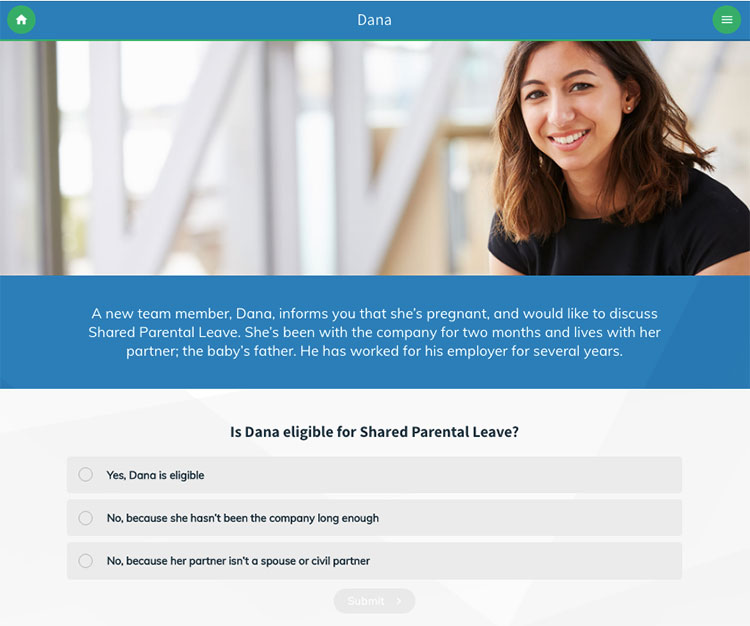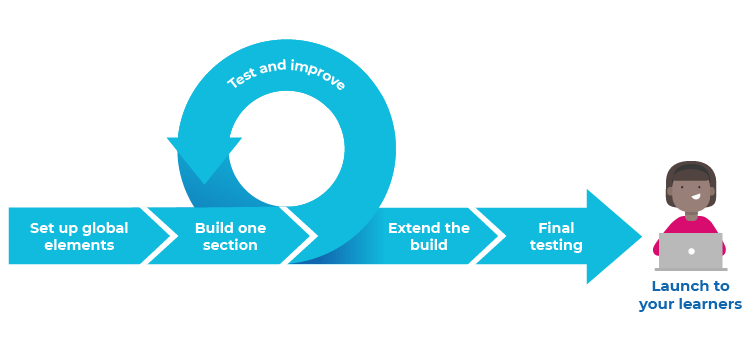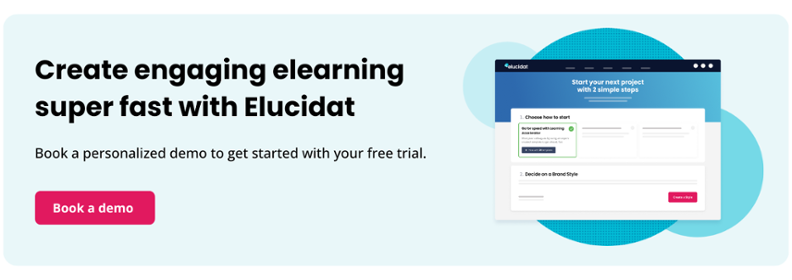The 5-step elearning content development process
7 minute read
Want a foolproof elearning content development process that delivers great results, every time? We’ve learned from the wins and war stories of hundreds of learning teams and boiled this down to five key steps for producing effective elearning.

The 5 essential steps for a successful elearning development process are:
- Set clear goals (Capture)
- Develop a design vision (Conceptualize)
- Create your content (Create)
- Analyze and iterate (Cultivate)
- Measure and optimize (Commercialize)
Step 1: Set clear goals (Capture)
To make sure your learning content is really going to resonate, the very first step of your elearning content development process has to be making sure you’re clear on exactly what you’re looking to achieve.
We call this the Capture stage, as it’s about capturing the problems, goals and audience profiles for your project.
Undertake learning needs analysis
The most successful elearning projects take time upfront to research users. This will help to make sure your project is working toward the right goals for impact. You need to ask why, why, why!
Have a set of questions to ask as part of learning needs analysis to help you truly identify what the real challenges are, why the performance isn’t as expected and what kind of problem it really is. After all, you can’t be sure that “learning” is the right fix to the problem. It might be that there’s a motivation issue, lack of awareness or a problem with the on-the-job tools or process.
Create user profiles
To change people’s behaviors and habits, you need to get under the skin of who your audience is and what their needs really are. This is at the very heart of the people-centered approach to developing elearning.
You should be asking: Who is your audience? What would really help them? What are their go-to places for help currently? What would motivate them to take action? To get this information, you’ll need to have conversations, run surveys, observe them, use learning analytics from previous projects and more.
Off the back of what you discover, you should try to find out more about each profile by being clear on questions like:
- What do you need them to do more of, or get better at?
- What’s blocking them from doing so right now?
- What will be genuinely useful to help them be successful?
- What will motivate them?
- When are they likely to learn?
- What do they need to learn, and what can they look up at the moment?
Set measurable goals
You need to be crystal clear how your elearning project is going to add value, and to whom. Work with stakeholders to decide on the goals you are going to measure for your learning project.
Think beyond mere completions and scores when you’re exploring the learning objectives. Look to measure performance impact, if no one else is! But also look at the softer but important stuff – user numbers, user feedback, peer and manager feedback on performances and more. The idea is to set out the data you’ll track and look for correlations with your elearning.
Download our project planning template to help with step 1
Step 2: Develop a design vision (Conceptualize)
Once you have clear goals, the next phase of a great elearning content development process is to work out how to meet them. We’d always recommend doing this collaboratively to help get the creative juices flowing. There are different methods at hand to help learning and instructional designers develop winning concepts you can then test out.
Start with concepts
Don’t start by looking at the course content! Think about what types of activities, experiences, tools and tips are most likely to work for the audience and goals.
Different approaches to this include:
- Mind mapping – explore ideas freely and sometimes collaboratively, primarily through text
- Storyboarding – set out a sequence of potential pages or videos, like a comic strip.
- Action mapping – a great way to build out solutions based on building competency and change (read more on Cathy Moore’s blog about this)
- Wireframing – set out layouts and sample content without getting caught up in styling
Take inspiration
Pull together mood boards or Pinterest pages of inspiring visuals, websites and other inspiration to test the water with your stakeholders. Check out our collection of awesome elearning examples to inspire you and your team (if you use Elucidat, we can gift some of these examples to you as a starting point!).
Build out prototypes
Once you’ve got the concept down, then prototype. This is a vital step in the content development process as it gives your stakeholders, and end users, something concrete to play around with and review.
Don’t make prototyping a big deal… do it early, do it regularly, do it collaboratively…and embrace that feedback to make the process count.

Get feedback and iterate
Be sure to work collaboratively and get input from your stakeholders. And, if you want an unbiased opinion on your course design, feedback or a steer, then seek help from specialist learning consultants. If you use Elucidat, then have a chat with our Learning Consultancy team, who’d love to help.
Download the free guide to conceptualizing your elearning ideas
Step 3: Create your content (Create)
At this stage, beware of those long, detailed documents and powerpoint presentations that your Subject Matter Experts (SME) may hand your way! Don’t let your exciting research-based design die with the introduction of boring content. Use your design model as the template, and use your SME to feed into the learning experiences you’re setting out to create.
Work collaboratively with your SME
This shouldn’t be the first time you talk with your SME. Work closely with them now to capture meaningful content that will work with the approach you’ve laid out in your design direction. Explain what content you need from them; don’t just hand over your wireframe for them to fill in the gaps. Stories and examples will trump facts. Get more tips on working with your SMEs here.
Consider curation
You don’t always need to start from scratch! Pull together existing resources and content that fits with your design model. For example, there may already be some great video content that explains the theory in a nutshell, existing on the job resources you could utilize, or a workshop activity you could rework into an assessment.
Build
Only when you know exactly what each page should include should you touch your authoring tool and start developing the elearning courses yourself. This shouldn’t be about “copy and paste content and job done.” Work smart, in a way that brings efficiencies and utilizes your teams’ skills. Collaborative authoring tools will enable your team to do this together and see progress if you’re working with a third party elearning production company.
The best process for building out your elearning content is:
- Set up your overall styling and navigation elements
- Set up any elements that will be replicated and re-used – e.g., topic structures, menus and/or pages you will re-use
- Build out one topic first – get stakeholder feedback and make changes
- Build out the other topics in parallel or one at a time – checking in on feedback as they are completed and making changes
- Q/A as you go, and always fully at the end

Download the free step-by-step guide for creating elearning
Step 4: Analyze and iterate (Cultivate)
As part of your elearning content development process, you must make room for reviewing its performance, gathering feedback and making improvements. This is key to making sure your elearning content is engaging, working for your learners and working as expected. You should use this data to make quick fixes.
Many modern authoring tools and platforms come with built-in analytics dashboards. Use these insights alongside qualitative feedback captured regularly from your stakeholders. If you don’t have a ready-made dashboard, consider setting one up in Excel or another dashboard tool – particularly for a large learning project.

Look out for:
- User numbers – are they where you’d expect?
- Session time – are they sticking around for long? Why (not)?
- Location – are you reaching everyone, everywhere?
- Devices – is mobile use where you’d expected? Is the session time telling?
- Drop-off points – what pages or activities are losing people?
- High hits – which pages or activities are getting most traffic?
- User feedback – what are users telling you about each digital resource, experience or topic?
Download the free guide to cultivating elearning with analytics
Step 5: Measure ROI and Optimize (Commercialize)
The analysis and creativity required to make an effective piece of learning can sometimes feel distant from the commercially-savvy mindset needed to drive revenue. But they aren’t mutually exclusive. In fact, thinking commercially at the start of a new project and incorporating plans for scalability can open up more design opportunities.
You should be in a position to be able to report on the success of the elearning content that you released and demonstrate the ROI.
But this step is also about thinking through how you can optimize the value. For example, you could look to:
- Reach new markets with your digital learning products
- Open up new revenue streams without starting from scratch
- Re-use aspects of the designs for future projects – styling, structure, design
- Localize and translate projects to extend their reach and impact
Consider how, as well as reporting on impact and value of your project so far (ROI), you can also make projections of where the investment can go next. We call this commercial thinking – but this doesn’t just apply to those who are selling elearning. It’s about being business-minded.
Download the free guide to commercializing your elearning content
These 5 steps are what we call the 5Cs Framework for successful elearning. It’s what our team uses every day when working with clients to produce elearning with Elucidat.
Download the free guide to building an outstanding elearning content development process




